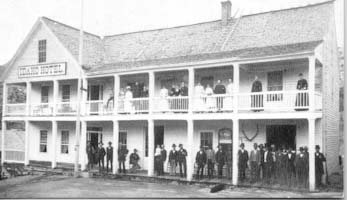Best Experienced With:
![]()
Click Here to start

|
Best Experienced With:
|
 Stagecoach EtiquetteIn the old days of the West, the only mode of public transportation was the stagecoach. Though on May 10, 1869 the famous "Golden Spike" was driven in Promontory Summit, Utah, and the track complete for America's first transcontinental railroad, the stagecoach would endure until after the turn of the century, replaced then by the automobile. Stage stops dotted the western plains like bus depots do today. And like independent bus companies of these modern times, there were independent stagelines during days of old. They came and went, flourished and died, starved out, sold out, and merged with others to grow larger and become stronger.
At the top of the heap after such a merger was Wells Fargo &
Company Overland Stage, who established among many stage stops one in
Silver City, Idaho, a mining district high in the Owyhee Mountains.
There, the Wells Fargo vault still stands (empty, of course), next to
the Idaho Hotel that was established during the boom of 1863. 
Journeys by stagecoach were long, dusty, and hard. Coaches were usually cramped and loaded down with heavy merchandise and luggage; passengers jammed in like sardines. It was not unusual for as many as twelve to fifteen people to be aboard at one time, some riding up front with the driver and atop the luggage. These crowded conditions required the establishment of company rules; a list of acceptable and unacceptable passenger behavior while aboard.
Since proper stagecoach etiquette was a must, the following was
posted in Silver City's Idaho Hotel stage depot:
|